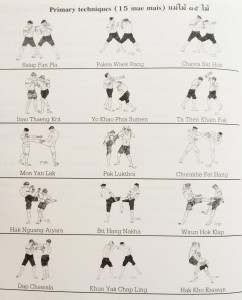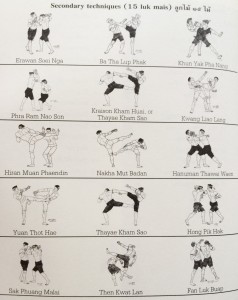1. The History of Muay Thai
Circa B.E. 1490 (A.D. 947) a group of Thais had settled down In the north. The settlement was led by Pu Chao Lao Chok who later ruled Fang and became the first king of the house of Lawachakarat, the predecessors of Mang Rai dynasty’s rulers of Lanna kingdom. The kingdom gradually reigned over the influence of the Khmer empire. Thai people eventually expanded to the northwest and established the Sukothai kingdom, and then to the Chao Phraya river area and established the Ayutthaya kingdom.
During the settlement, the warnorinstinct Thais had developed barehanded fighting skill which became the martial art for engaging at close quarters. New techniques were invented to employ various body parts as weapons which improved the maneuvers over time. The barehanded fighting was later welladapted to weapons like swords and shields, which increased the efficiency of fighting and self-defense.
In a chapter of Mang Rai Sat (the law of Mang Rai), the palm leaf inscription in Lanna or Thai Yuan language, belled to be from B.E. 1839 at the same time that King Mang Rai built Chiang Mai, mentions the term «muay» for the first time, which Is a primary evidence that muay Thai has at least existed since then.
2. Ancient Muay Thai textbooks
The oldest muay Thai textbook was written in the reign of King Rama III (B.E. 2367-2394 or A.D. 1824-1851) which
described the four basic attacks of muay: thum, thap, chap, hak. (The Picture book archives No. 10/Ko, Roll 3, Cabinet 117, Thai National Library.)
Thum is to grapple the opponent and throw him to any directions.
Thap is to jump and attack with buttock to the opponent, as if trying to sit on him.
Chap is to hold or lock the opponent.
Hak is to physically damage the opponent’s arms.
3. Muay Lak and Muay Kiao
Muay Thai is a unique martial art in part of the digenously passed down to become a cultural identity. Muay Thai employs all body limbs — throwing feet, knees, elbows, fists, and head. In a close range fight muay Thai fighters can hug, wrestle, seize, knock, head butt, or slam the opponents defensively and offensively.
The apprenticeship of muay Thai requires self-disciplme and a lot of physical and mental stamina. It takes a lot of time, best started at the young age of 9 or 10. The practitioners also require ethical and moral study, learning to focus, be calm, and not be enraged so that their minds stay sharp and alert.
Muay Thai has two styles of boxing:
Muay lak (firm boxing style) is the style of precautious movements which may seem slow but smart. The stance and move are strong and confident. The apprentices of this style are trained with defensive tactics, waiting patiently for an opportunity. The attack is intense and the throw of limbs is precise. This style is suitable for a large built and calm person.
Muay kiao or muay on (agile boxing style or soft boxing style) is the style of energetic, agile movement which makes
it hard to predict the opponent. This style requires keen eyes and good maneuvers. It is said that to strengthen leg muscle the apprentices must exercise doing footwork in water and splashing it around all the time without closing their eyes. This style is suitable for a rather thin, small built person.
Muay lak and muay kiao have a distinction in that the former uses feet, knees, fists, and elbows more
intensely, while the latter uses those limbs more actively. The decision of style depends upon to the physical and mental conditions of individuals. Medium built persons may be trained with the combination of both styles, resulting in both agility and strength.
The best training, however, should comprise of both muay lak and muay kiao to ensure that the trainees are familiar with offensive and defensive techniques.Rigorous, serious training over years is necessary for someone to achieve muay Thai apprenticeship.
4. Style, Mae Mai, and Luk Mai of Muay Thai
Mae mai and Ink mai are the offensive or defensive techniques with agraceful style and formidable movement. They are both art and science tndigenously : invented by Thai ancestors to become a cultural legacy for thousands of years.
The following illustrations and descriptions depict the training of yang sam khum footwork, the series of long and short striking movement for defensive and offensive purposes, and the counterattack movements showing the target to suppress the opponent.
Muay Thai practitioners are required to master the skill of the 15 mae mats (primary techniques), before learning the 15 luk mais (secondary techniques), as follows:
Primary techniques (15 mae niais)
1. Salap Fan Pla
2. Paksa Waek Rang
3. Chawa Sat Hok
4. Inao Thaeng Krit
5. Yo Khao Phra Sumen
6. Ta Then Kham Fak
7. Mon Yan Lak
8. Pak Lukthol
9. Chorakhe Fat Hang
10. Hak Nguang Aiyara
11. Bit Hang Nakha
12. Wirun Hok Klap
13. DapChawala
14. Khun Yak Chap Ling
15. Hak Kho Erawan
Secondary techniques (15 luk mais)
1. Erawan Soel Nga
2. Ba Tha Lup Phak
3. Khun Yak Pha Nang
4. Phra Ram Nao Son
5. Kraison Kham Huai, or Thayae Kham Sao
6. Kwang Llao Lang
7. Hlran Muan Phaendin
8. Nakha Mut Badan
9. Hanuman Thawai Waen
10. Yuan That Hae
11. Thayae Kham Sao
12.Hong Pik Hak
13. Sak Phuang Malai
14. Then Kwat Lan
15. Fan Luk Buap

